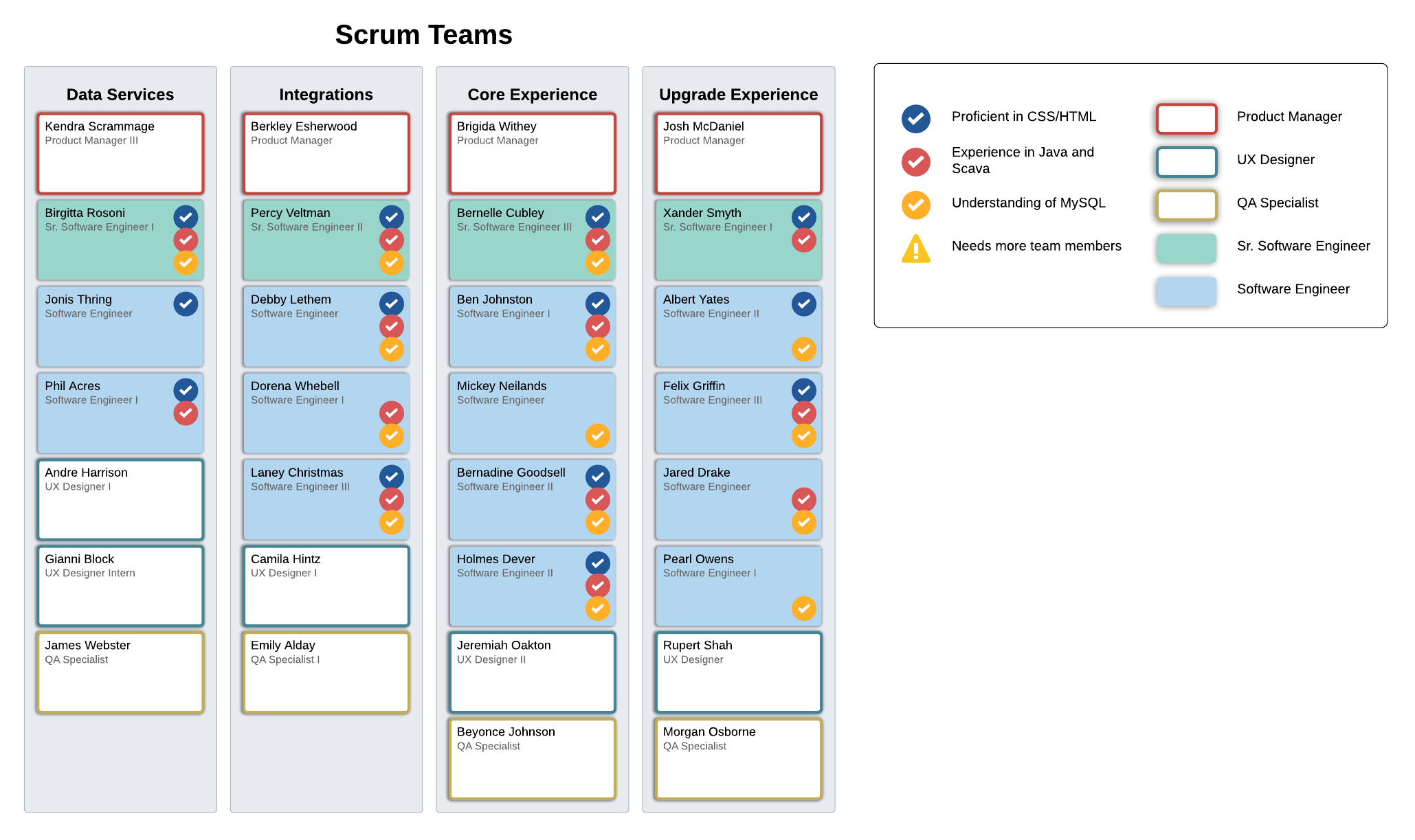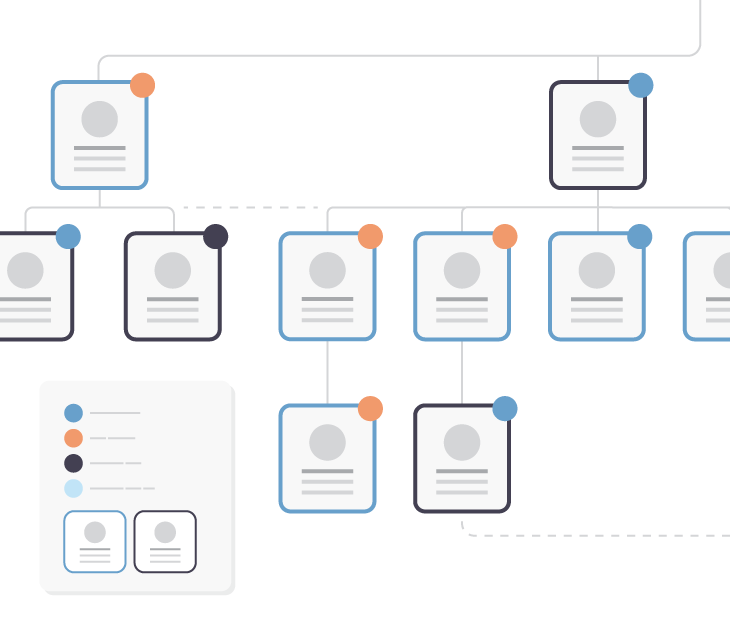
How to build a Scrum team structure for Agile development
Reading time: about 7 min
Topics:
As the pace of business continues to accelerate, more and more organizations are turning to Agile to keep up.
And with top business priorities revolving around fulfilling customer needs, improving time to market, and reducing cycle time, the Scrum team structure has become the obvious answer for many organizations.
Below we will cover what Scrum is and how you can build an effective Scrum team for Agile development.
What is a Scrum team?
Scrum is an iterative framework for implementing Agile. The Scrum framework applies empiricism, lean thinking, and continuous improvement so that teams can work together effectively to deliver value.
Guided by values and a few rules, Scrum provides a flexible framework for teams to follow and adapt to their specific projects and development environments. This flexibility makes it an appealing structure across teams and organizations.
The basic Scrum framework is composed of the following elements:
- Three Agile Scrum team accountabilities: product owner, Scrum master, and the developers
- Five Scrum events: the sprint, sprint planning, daily Scrum sprint review, and sprint retrospectives
- Three Scrum artifacts: the product backlog, sprint backlog, and increments
Scrum team composition
The typical Scrum team size is five to nine people (with seven being the ideal—one product owner, one scrum master, and five developers).
Unlike traditional development structures, Scrum teams don’t have a structural hierarchy. Instead, they are self-managing and cross-functional. All team members are equally important and together have all the skills and knowledge necessary to deliver a working product.
While everyone has an equal voice, there are three distinct roles within the Scrum team structure.
Product owner
The product owner is the champion of the product and the foundation for its success. Their main responsibility is understanding the business and customer requirements and defining and prioritizing the work accordingly.
This role entails the following:
- Developing and communicating the product goal
- Building and managing the product backlog
- Ordering items in the product backlog
- Keeping the product backlog transparent to the team and ensuring it is understood.
In other words, the product owner acts as a guidepost for the team throughout the development process. While all team members will collaborate and discuss how to tackle the work, the product owner has the final say on what to prioritize and when.

Dive deeper into the key responsibilities of the product owner.
Learn moreScrum master
The Scrum master helps the team apply the Scrum framework successfully. They ensure the team functions smoothly by reigning in overbearing product owners, minimizing distractions, and coaching the team on best practices.
The Scrum master also facilitates the daily Scrum meeting, which helps the team stay on task.
Developers
The developers are the foundation of the Scrum team. While the product owner outlines the priorities and the Scrum master serves the process, the developers are responsible for determining how to get the work done.
They are essentially autonomous (one feature that makes Scrum unique from other frameworks or methodologies). This feature makes Scrum teams highly collaborative and close-knit, often resulting in higher morale, satisfaction, and purpose.
Benefits of an agile team structure
The Scrum team structure is a popular approach for many teams—and for good reason. Scrum has several advantages:
1. Shorter feedback cycle
Due to their incremental approach to development, Scrum teams can receive and act on feedback faster.
For example, instead of spending six months developing and then releasing a product based on the original requirements, Scrum teams shorten the development cycle with multiple, shorter releases (often within a few weeks).
This structure allows them to get feedback earlier in the development process and adapt the product based on their learnings and user feedback.
2. Greater ability to adapt to change
Scrum teams are designed to expect and adapt to change. Agile frameworks like Scrum make it easy for teams to pivot based on user feedback and changing requirements as they arise—instead of letting these changes disrupt or derail the development process.
3. Higher quality products
Because Scrum teams are agile, they can deliver higher quality products with greater consistency. In addition to receiving and adapting to incremental feedback, Scrum teams also test the product at every sprint, ensuring issues are identified and handled as they occur.
4. Transparency
Transparency and communication are key principles of the Scrum framework. The product owner and stakeholder(s) take active roles in the development process.
Therefore, transparency is critical for both internal team collaboration and external client (or user) communication so that the work always aligns with the product goals and requirements.
5. Higher user satisfaction
With higher-quality outcomes, responsive feedback loops, clear communication, and managed scopes, it is no wonder Scrum teams so frequently experience higher user satisfaction.
6. Shared team purpose
The culture of Scrum is one of collaboration. The heart of the Scrum team is the developers. Because there isn’t a traditional hierarchy with a team boss, and the work itself is structured collaboratively, members have a shared sense of ownership for the product.
This sense of ownership improves morale, gives the team purpose, and helps everyone work more productively.
When to use a Scrum team structure
Scrum teams can work on different types of software development, including full software packages, client, or internal work. While Scrum is a flexible and valuable approach for many types of work, there are a few ways to recognize when it is best applied.
When requirements are not clearly defined
Sometimes clients have a general vision for their product but lack clear requirements. This can make it difficult to estimate the scope of time and costs necessary for fixed-cost projects or more traditional methodologies.
The Scrum framework is built to adapt to evolving requirements, making it the natural choice for projects with undefined scopes.
When changes are expected during development
Similarly, Scrum works especially well for products that anticipate changes during development. This can happen even when requirements are clearly defined from the outset.
For example, changes in the business environment or evolving technologies can affect product requirements mid-project. Scrum’s agile structure makes it easy to pivot to accommodate changes throughout the development process.
When the product is complex
Complex problems are difficult to address effectively and efficiently in traditional development methodologies. The more complex the product, the more issues that can arise as you go.
Scrum is well-equipped to handle complex projects because it breaks them down iteratively and incrementally. Rather than trying to anticipate all the requirements in one plan at the beginning of the product, Scrum teams work on it piece by piece, adapting as they learn.
Picking the right people for your Scrum team
To build a successful Scrum team, you need to bring together the right people. But what do you look for?
A good Scrum team is:
- Collectively accountable for the work
- Autonomous and self-organizing
- Cross-functional and balanced
Additionally, look for a product owner who is fully available to the team. They must be fully involved to ensure the team has the right priorities and guiding requirements along the way.
When you have determined the key competencies required for a given product, consider using a visual workspace to highlight employees with the necessary strengths and skill sets. In Lucidchart, you can generate an org chart from employee data, add conditional formatting, and group employees by various factors.

To further increase collaboration, consider using a virtual whiteboard like Lucidspark. Lucidspark provides a space for teams to consistently return to share ideas and notes, reference progress, and solve problems. Visual collaboration with Lucidchart and Lucidspark is particularly useful for remote or hybrid teams as it makes it easy to stay aligned and collaborate continuously.

Though Scrum is not difficult to implement, consistently delivering real value is never easy. Teams that want to succeed in an Agile environment must commit to the process and their own personal and collective growth. Those that do are the ones who will stay ahead of the curve.

Visualize your org to align Scrum teams with your business strategy.
Learn moreAbout Lucidchart
Lucidchart, a cloud-based intelligent diagramming application, is a core component of Lucid Software's Visual Collaboration Suite. This intuitive, cloud-based solution empowers teams to collaborate in real-time to build flowcharts, mockups, UML diagrams, customer journey maps, and more. Lucidchart propels teams forward to build the future faster. Lucid is proud to serve top businesses around the world, including customers such as Google, GE, and NBC Universal, and 99% of the Fortune 500. Lucid partners with industry leaders, including Google, Atlassian, and Microsoft. Since its founding, Lucid has received numerous awards for its products, business, and workplace culture. For more information, visit lucidchart.com.
Related articles
The roles and responsibilities of a Scrum master
Are you considering becoming a Scrum master? In this article, learn more about Scrum master skills, the role, and responsibilities.
How to manage Scrum teams in Lucidchart
At Lucid, we have been able to form Scrum teams of engineers, product managers, QA specialists, and UX designers using the org chart functionality in Lucidchart. Let me walk through the process so you can try it out at your own company.
